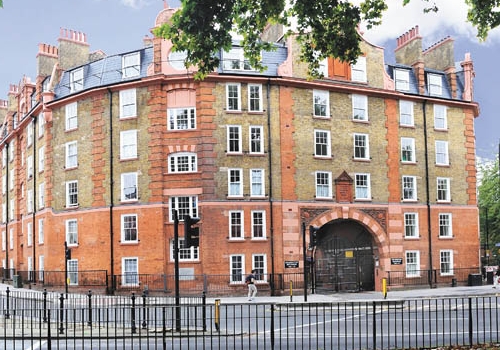Property News: Renovation work on social housing pioneer Goldington, could sustain it for next century

Published: 20 October 2011
by DAN CARRIER
IT was the first social housing to be built in what was then the borough of St Pancras – and now the late Victorian flats known as the Goldington Buildings have had a renovation that should see them good for the next 100 years.
The 1902 structure, situated on the corner of St Pancras Road and Crowndale Road, has offered shelter for workers since 1902, many of them employed through the nearby railway stations.
The improvement project was undertaken by social housing group Origin, along with Camden Council. It included cutting the numbers of flats in the building and making those available much bigger.
Architect Tim Johnstone, who headed the project, has converted what originally was designed to provide accommodation for more than 300 people. It is now under half that figure.
He said: “The crucial thing about the work we had to do related to Goldington being designed for a totally different standard of living.”
That meant creating one flat out of what was previously two – by extending both horizontally and vertically. A major issue Mr Johnstone had to overcome was the rigid nature of the original designs – in many places the walls are around a metre thick, partly due to the number of rooms that had to contain a fireplace and flue.
The foundations of the building were set on the undeveloped marshy ground on the banks of the Fleet river, which might explain their size and depth, as well as the massive construction of the building itself.
The latter made use of good quality brickwork, with bulky external walls and even thicker cross walls honeycombed with chimney flues that rather dominate the internal layouts.
Use was also made of an unusual type of early, mass fill, clinker concrete construction for the floors, spanning between steel beams bedded into the cross walls.
Mr Johnstone said: “This was a very well-built block, partly due to the fact the foundations are so solid as they sit on land that once had the River Fleet flowing through it. They built it to last.
“The critical issue was how to create the right amount of space. We had to make sure we created it to modern standards, such as making sure the kitchens were up to date.”
The interiors were plain – built for labourers, there was little inside in terms of interior design, which meant the architects did not have the problem of restoring period features.
Yet they did ensure the landmark exterior was completely renovated to be as good as it was when it was first occupied.
Mr Johnstone added: “It is a utilitarian building but the people who lived here felt they were extremely lucky.”
All 30 of the homes have already been let.
Town Hall housing chief Labour councillor Julian Fulbrook said: “This is an excellent example of partnership working which is creating modern, high-quality homes in Camden. I’m delighted to see these family-sized homes become available to our residents and they will help to tackle our housing shortage.”



